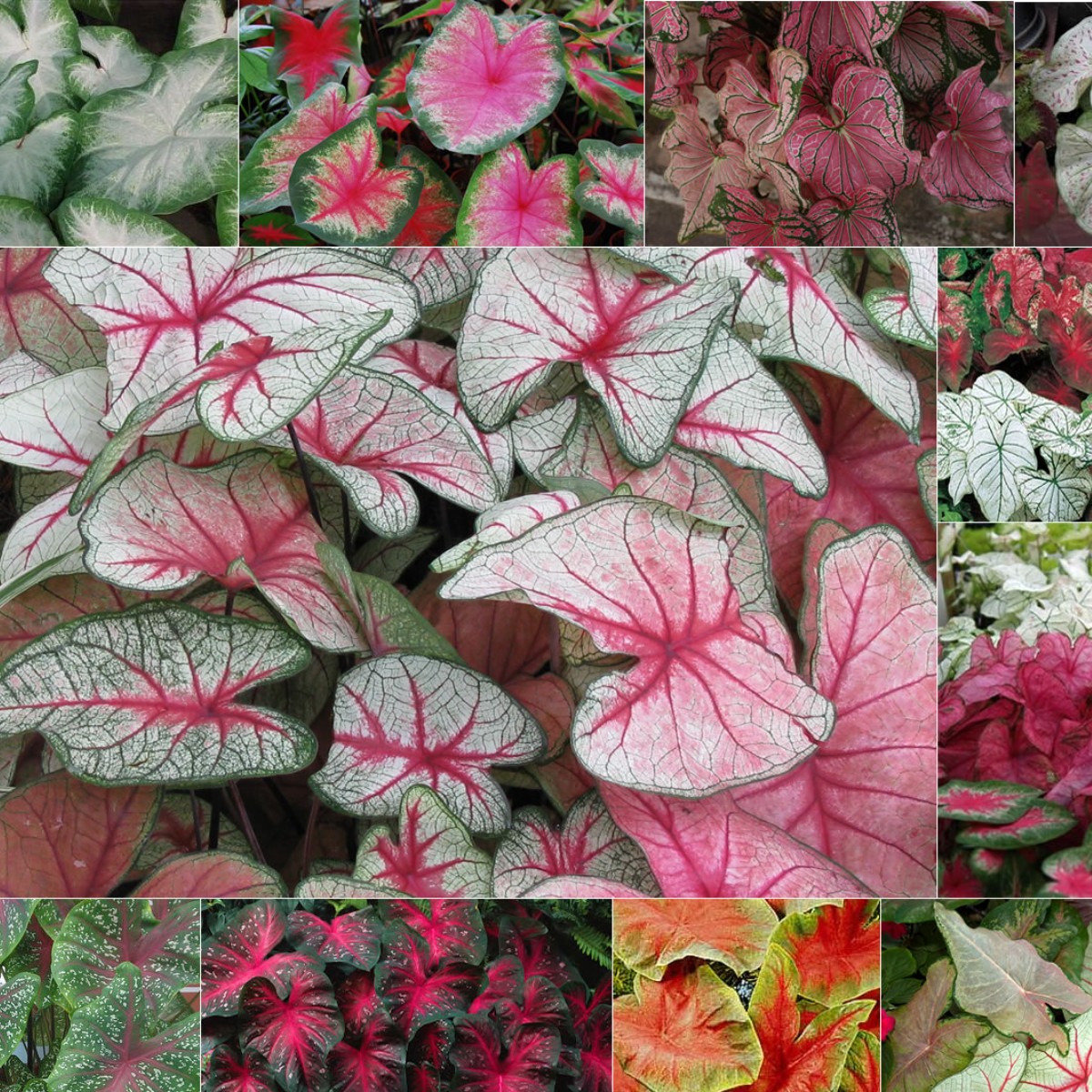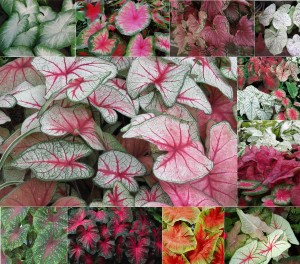Family: Araceae
Synonymous: Caladium bicolor
Arum bicolor
Distribution and habitat: The genus Caladium indigenous to South America. They grow in open areas of the forest and on the banks of rivers and go dormant during the dry season. The wild plants grow to 4090cm (1535 inch) tall, with leaves mostly 1545cm (6-18 inch) long and broad and have subtle white flowers.
Description: Caladium species are tuberous-rooted plants with heart-shaped leaves or arrow-shaped leaves on long stalks rising directly from the tubers. The Caladium species in cultivation are hybrids of mixed origin that are usually grouped under the name Caladium X hortulanum; many of them are known by varietal names.
The size of the paper-thin leaves varies considerably, but an average leaf in 30-38cm (12-15 inch) long on a similar length stalk. Colour can be practically all white with just the fainest tinge of green along the veins; or the leaves can be spotted, veined, blotched or marbled red, pink or white on green. Some kinds have much smaller than average, predominantly green foliage and these are far the easier to grow than the others. Although all varieties have flowers, they are grown for their spectacular foliage, rather than for flowers.
Houseplant care: All these plants need usually constant high humidity to maintain healthy foliage; since this is diffcult to achieve indoors, Caladium X hortulanum are often grown as temporary plants - very ornamental for short period when they are in leaf, but discarded when pass their prime. It is not necessary to discard them, however. After the leaves have died down, dormant tubers can be kept in their pots and given the right condition, will produce new growth in the following year.
Light: Caladium X hortulanum require bright light, but must not be exposed to direct sunlight.
Temperature: A temperature of at least 18-24C (64-75F) with a correspondingly high degree of humidity is essential for plants in leaf; pots should be kept on trays with moist pebbles and foliage mist-sprayed daily. Caladium X hortulanum must never be exposed to droughts or the leaves will crumple up within an hour or two.
Store dormant tubers in the dark at a temperature of about 15C (59F).
Water: Caladium X hortulanum are plants of tropical jungles. During the active growth period therefore, water them moderately, enough to make the entire potting mixture moist. But, as leaves begin to dry out and die down, reduce the frequency of watering. The tubers require a rest period of at least five months, from early autumn through early spring and during those months they should be watered only sparingly (once a month, say).
Fertilising: Apply half-strength standard fertiliser every two weeks in the active growth period only.
Potting and repotting: Use a peat based potting mixture and put fragments of clay pot or other drainage material in the bottom of the pot to improve drainage. Dormant tubers should be potted in fresh potting mixture in spring. Pots about 8cm (3 inch) in size are adequate for small tubers and for these with small leaves; 13cm (5 inch) pots are best for larger plants. Tubers should be buried at about their own depth from the surface - plant a 2cm (0.8 inch) thick tuber about 2cm (0.8 inch) below the surface. Maintain a temperature of at lest 21C (70F) to start growth.
Garden Culture: Caladium X hortulanum tubers need to be dug and stored each year before frost. Even in locations where Caladium X hortulanum may be left in the ground, the tubers seem to perform better when dug and protected from wet winter soils. Water should be gradually withheld as the leaves naturally start to yellow in fall, then the tubers dug, cleaned of soil and left to dry in semishade for about 10 days. The tubers should be dusted with an insecticide-fungicide prior to being stored in dry peat moss or vermiculite at temperatures between 10-16C (50-60F). This helps prevent rot.
Caladium X hortulanum require a warm, moist soil. A minimum soil temperature of 21C (70oF) is preferred. If planted too early in the spring, cool soil temperatures will cause tubers to rot before they sprout.
In the warm, humid climates of zones 8 and 9, plant Caladium X hortulanum tubers directly into the ground in spring. In most other areas, to start Caladium X hortulanum indoors for outdoor planting, pot them up about 4-6 weeks before transplanting them in garden. Wait until the soil warms to plant outdoors. Peat pots will make transplanting easier on the plants.
Also, these species can be grown in containers in shaded positions outdoors. The great advantage of pot-grown Caladium X hortulanum is that they can be moved as needed to keep them warm. When nights become chilly in fall, bring them indoors and keep them in a sunny window, until the leaves begin to wither.
Position: Caladium X hortulanum grow best in the partial shade of open, high-branched trees. They will perform reasonably well in full shade, but the color may not be as outstanding. Generally they will need protection for the direct sun light.
When grown around the bases of trees, make a 13cm (5 inch) deep bed of rich soil so the tuberous roots will have adequate space and a fair chance at moisture.
Soil: Grow Caladium X hortulanum in acidic soil that is moist and well drained. For best growth, a layer of pine bark mulch or compost should be incorporated into the soil to improve soil aeration, drainage and organic matter content.
Plant tubers 5cm (2 inch) deep and 20cm (8 inch) apart for small tubers and 30cm (12 inch) apart for large tubers.
Water: Caladiums are not drought tolerant and should be watered on a regular basis, but do not overwater them.
Add mulch to conserve moisture and keep the soil cool during the hot summer.
Fertiliser: Feed outdoor planted Caladium X hortulanum once a month during the active growth period. Do not allow fertilizer to contact the leaves. Water thoroughly after fertilization to prevent fertilizer burn.
Propagation: Detach small tubers from the parent at the time of restarting into growth. If it is potted up and cultivated as recommended above, each tuber will produce a new plant. The new tubers reach their maturity in one to two years.
Problems: Any problem (such as premature withering of the leaves) is likely to be caused by failure to provide suitable conditions: constant warmth and a high humidity are essentials.
Availability: Caladium X hortulanum can be bought as potted plants or as dormant tubers.
Toxicity: The Caladium X hortulanum plant may be poisonous so keep it away from pets and children. Contact with Caladium X hortulanum sap may irritate sensitive skin.
Uses: Caladium X hortulanum grow rapidly and are beautiful indoors as well as in a garden. Indoors, Caladium X hortulanum, because their need of high humidity, are best grown among other plants needing similar conditions.
It is excellent for providing foliage color spring, summer, and fall. This plant is primarily grown for its attractive foliage and is suitable for borders, containers and as a specimen.
Grouped together, they can look like they are in bloom. Caladiums grow equally well in containers and pair nicely with ferns and other soft textured plants like Astilbe species, with spiky leaved plants such as ornamental grasses and shade tolerant Iris and with coordinating colored blooms of Fuchsia and Impatiens.
SUMMARY:
CHARACTERISTICS:
Foliage coloured
Shape bushy
Height: 30-45cm (12-18 inch)
PROPER CARE:
Watering in rest period sparingly
Watering in active growth period moderately
Light bright
Temperature in rest period min 16C max 18C (61-64F)
Temperature in active growth period min 16C max 24C (61-75F)
Humidity high
Hardiness zone: 8b-11





